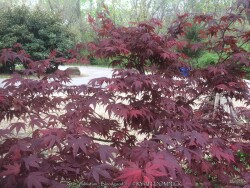

Bloodgood Japanese maple (Acer palmatum 'Bloodgood') is a small tree with gracefully branched stems and palmate red-purple leaves that turn bright red in the fall. Bloodgood has improved purplish maroon summer foliage color.Used in Kansas landscapes small lawn tree or understory tree in full to part shade needing rich, moist soils. Even with ideal growing conditions, growth is slow. Avoid afternoon sun in the heat of summer as leaf tips will burn. I have seen tremendous late spring freeze damage on rare occasions.


***Description comming later*** from Heritage Nursery "A fine cultivar distinguished by its bright red foliage. Whereas the more widely available cultivar, 'Bloodgood' has a maroon color, this one is redder, especially when the sun shines through the leaves. Leaves emerge two weeks later than 'Bloodgood'. Milwaukee, WI city arborists consider 'Emperor I' hardy within their urban area."


Oshio Beni Japanese maple (Acer palmatum 'Oshio Beni') is a small tree with gracefully branched stems and palmate red-purple leaves that turn bright red in the fall. Oshio Beni has improved purplish maroon summer foliage color and bright red-orange new growth in teh spring. Used in Kansas landscapes small lawn tree or understory tree in full to part shade needing rich, moist soils. Even with ideal growing conditions, growth is slow. Avoid afternoon sun in the heat of summer as leaf tips will burn. I have seen tremendous late spring freeze damage on rare occasions.
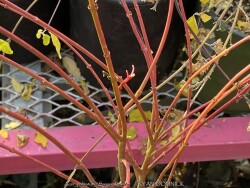

Sango Kaku Coral-twig Japanese Maple (Acer palmatum 'Sango Kaku') is a small tree with gracefully branched stems and palmate reddish-green leaves that turn bright red in the fall. Sango Kaku has amazing winter twig color that is a bright coral-red-orange color. Used in Kansas landscapes small lawn tree or understory tree in full to part shade needing rich, moist soils. Even with ideal growing conditions, growth is slow. Avoid afternoon sun in the heat of summer as leaf tips will burn. I have seen tremendous late spring freeze damage on rare occasions so cover if growth has started if the forcast calls for 28 degrees F or lower.
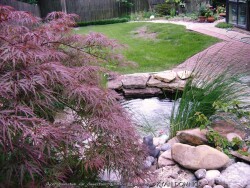

Crimson Laceleaf Japanese Maple (Acer palmatum var. dissectum 'Crimson Queen') is typically a much smaller, rounded, slow-growing shrubby form with deeply cut feathery leaves often with cascading branching. 'Crimson Queen' is a maroon red leaf variety. Used in Kansas landscapes as a specimen plant often near a waterfall or focal point. Needs full to part shade with rich, moist soils. Even with ideal growing conditions, growth is slow. Avoid afternoon sun in the heat of summer as leaf tips will burn. I have seen tremendous late spring freeze damage on rare occasions.


***Description comming later*** from Heritage Nursery "Among the best of the weeping red laceleaf maples, known for its leaf color retention in summer, its scorch resistance, vigor, and hardiness. Always popular and attractive."


***Description comming later*** from Heritage Nursery "This beautiful gem is more strongly weeping than most other selections of its kind. It goes through a kaleidoscope of reds, greens, and orange all season long."


***Description comming later*** from Heritage Nursery "Among the best of the weeping red laceleaf maples, known for its leaf color retention in summer, its scorch resistance, vigor, and hardiness. Always popular and attractive."
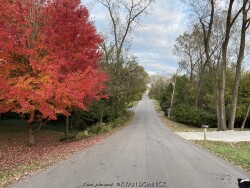

Red maple (Acer rubrum) is a large landscape tree common in Kansas and popular for its red to orange fall color and red spring flowers. While it does well in many soil types including wet compacted clays, it will struggle in an open exposed windy sites if drought stressed. Sun scald is another significant problem that can be prevented with protection or proper siting. The Red Maple has many claims to fame, including the greatest north-south range of any tree species living entirely in the eastern forests from Canada to southern Florida everglades. Its western native range is limited by lack of regular moisture, high pH soils, and intolerance to prairie wildfires.
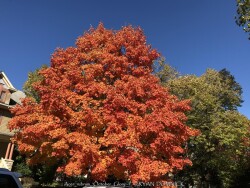

Red maple (Acer rubrum) is a large landscape tree common in Kansas and popular for its red to orange fall color and red spring flowers. While it does well in many soil types including wet compacted clays, it will struggle in an open exposed windy sites if drought stressed. Sun scald is another significant problem that can be prevented with protection or proper siting. The Red Maple has many claims to fame, including the greatest north-south range of any tree species living entirely in the eastern forests from Canada to southern Florida everglades. Its western native range is limited by lack of regular moisture, high pH soils, and intolerance to prairie wildfires. Acer rubrum 'October Glory' is noted for outstanding, reliable, bright orange to deep, reddish purple fall color - even in warmer climates. Foliage is also held on the tree later into fall than with most cultivars.
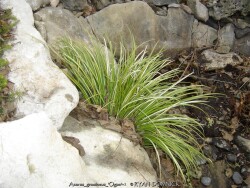

Golden Variegated Japanese Sweet Flag (Acorus gramineus 'Ogon') is a semi-evergreen marginal aquatic perennial. In constant wet conditions, it handles full-sun. It features a bright greenish-yellow grass-like tufts of narrow leaf blades. It is native to wetland areas of China, Japan, Korea, India, Thailand, Myanmar and the Philippines. In Kansas, it is very useful as a reliable rain garden plant or average garden plant in soils that do not dry out in full to part shade. Also useful on north walls and areas without tree-root competition. It cannot handle prolonged Kansas droughts or dry-shade. Foliage will flatten to the ground during brief drought then spring back up when moisture is available again. In Eastern Kansas, typically our 40 inches of rainfall is sufficient without extra water if planted in good soils. Generally however, in non-irrigated areas with poor soil, this plant will decline and allow weeds to invade. Foliage is evergreen (bright chartreuse-green) down to -5 to -10 degrees F offering valuable winter color.
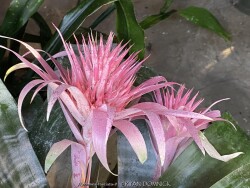

Silver Vase / Urn Plant (Aechmea fasciata) is an exotic-looking flowering plant from the bromeliad (Bromeliaceae) family. Despite its exotic appearance and tropical nature, this bromeliad adapts well to living as a potted house plant. In Kansas, use as a summer patio plant and protect from direct sunlight in mid summer and any temperatures below 50 degrees F in the spring or fall. As an epiphyte, much of its water needs are met by keeping the plants center "Urn" filled with water once per week or two. They have a shallow root systems and probably won't ever need repotted. When flowering, the flowers themselves are short-lived, but the pink and red bracts last for a few months.
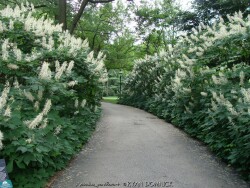

This species (Aesculus parviflora) grows as a large suckering deciduous shrub in evenly moist, well-drained soils in part shade to full shade. The species is native to the southeastern United States, where it is found primarily in Alabama and Georgia but is hardy much further North to zone 5. Useful in Kansas landscapes in rich established forest areas or along stream banks with plenty of room. Tends to thrive in rich forest soils of Eastern Kansas just fine without irrigation but is not known to tolerate moderate to drought. Bottlebrush buckeye features large palmate green leaves and tall cylindrical panicles (to 12" long) of tubular white flowers with conspicuous red anthers and pinkish filaments. Mid-summer bloom will not go unnoticed!
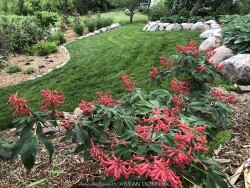

Red Buckeye (Aesculus pavia) is a valuable small tree or shrub is native to the southern and eastern parts of the United States. Grow in average, medium moisture, well-drained soil in morning sun to full shade. In Kansas, growth is slow but flowers at a very young age when only a couple feet tall making it useful as a flowering shrub for the first 10-20 years. Then you can allow it to grow into a small tree. Tall ruby red flowers bloom for about a month close to redbud bloom timing and hummingbird migration back to the area. Attractive brown fruits are produced in August/September and are favored by squirrels as their first fall nut crop. Foliage is dropped rapidly making it one of the first shrubs or trees to drop its leaves sometimes as early as late September. This is rarely a problem though, as there are many other things happening in the garden in the fall.
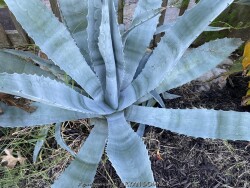

Powder Blue leaves from this agave (Agave americana) make an excellent architectural statement. Used as a patio plant in Kansas, place in full sun with no extra watering except from rainfall. Repotting may or may not be needed depending on how large you want the plant to grow. Potted plants are hardy to at least 20 degrees F if kept dry so you can wait awhile to move these in for the winter. Then move into a cold garage, basement, or window over the winter with NO watering. Luckily monocarpic flowering will never occur in a potted agave so you don't have to worry about death after flowering. A suggestion to make this plant a lot more safe around your eyeballs is to clip the new spines off as the new leaves slowly unfurl. As a winter-only house plant, it will look presentable all winter long with just no waterings. As a permanent house plant, provide bright light and allow the soil to dry between waterings for many years of carefree enjoyment.


Powder Blue leaves from this agave (Agave parryi var. couesii) make an excellent architectural statement. Used as a patio plant in Kansas, place in full sun with no extra watering except from rainfall. Repotting may or may not be needed depending on how large you want the plant to grow. Potted plants are hardy to at least 0-5 degrees F if kept dry so you can wait awhile to move these in for the winter. Then move into a cold garage, basement, or window over the winter with NO watering. Luckily monocarpic flowering will never occur in a potted agave so you don't have to worry about death after flowering. A suggestion to make this plant a lot more safe around your eyeballs is to clip the new spines off as the new leaves slowly unfurl. Although un-tested by the author, this agave could survive in a microclimate under a south facing roof overhang kept completely dry in the winter and controlled water in the summer. A planting in Stillwater Oklahoma has survived 20 years on an exposed sandstone retaining wall and endured temperatures as low as negative 19 F one winter and a week of negative night temperatures in 2021 with some foliage damage. As a winter-only house plant, it will look presentable all winter long with just no waterings. As a permanent house plant, provide bright light and allow the soil to dry between waterings for many years of carefree enjoyment. An large established potted plant in our Lawrence, KS (zone 6a) cold frame survived 0 degrees F for a couple days and lows in the single digits or teens for a week. It was kept dry but with no mulch or protection, accidentally being left on a raised greenhouse bench. It appeared frozen solid with a leaf breaking off and ice crystals visible! Amazingly, absolutely no damage occured when it thawed; must be filled with some kind of natural antifreeze or stretchy cell walls!
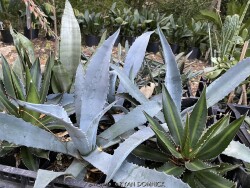

Powdery Blue leaves from agave make an excellent architectural statement. Used as a patio plant in Kansas, place in full sun with no extra watering except from rainfall. Repotting may or may not be needed depending on how large you want the plant to grow. Potted plants are hardy to at least 20 degrees F if kept dry so you can wait awhile to move these in for the winter. Then move into a cold garage, basement, or window over the winter with NO watering. Luckily monocarpic flowering will never occur in a potted agave so you don't have to worry about death after flowering. A suggestion to make this plant a lot more safe around your eyeballs is to clip the new spines off as the new leaves slowly unfurl. As a winter-only house plant, it will look presentable all winter long with just no waterings. As a permanent house plant, provide bright light and allow the soil to dry between waterings for many years of carefree enjoyment.
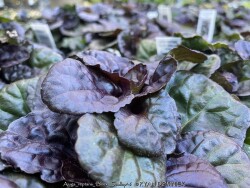

Ajugas are extremely hardy groundcovers that quickly form a dense carpet-like mat. Unlike many perennials that are grown only for their flowers, Ajuga is prized for its attractive, evergreen colorful foliage that looks nice all year. The deepest foliage color is achieved when plants are sited in full sun and in cooler temperatures although in Kansas this may result in foliage burning in summer if not adequately watered. From mid to late spring, short deep blue flower spikes stand upright above the foliage. Do not allow foliage to be covered with leaves or mulch during winter or crown rot disease may occur wiping out large patches. Ajuga reptans 'Black Scallop' tends to spread more slowly and stay naturally compact compared to other varieties of Ajuga, making it suitable for use as an edging, rock gardens, walking trails borders and mixed container plantings. This attractive small-scale variety has glossy, near-black, scalloped leaves and a dense habit.
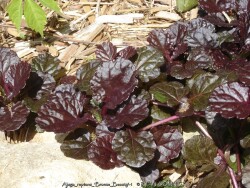

Ajugas are extremely hardy groundcovers that quickly form a dense carpet-like mat. Unlike many perennials that are grown only for their flowers, Ajuga is prized for its attractive, evergreen colorful foliage that looks nice all year. The deepest foliage color is achieved when plants are sited in full sun and in cooler temperatures although in Kansas this may result in foliage burning in summer if not adequately watered. From mid to late spring, short deep blue flower spikes stand upright above the foliage. Do not allow foliage to be covered with leaves or mulch during winter or crown rot disease may occur wiping out large patches. Ajuga reptans 'Bronze Beauty' tends to spread more slowly and stay naturally compact compared to other varieties of Ajuga, making it suitable for use as an edging, rock gardens, walking trails borders and mixed container plantings. This attractive small-scale variety has glossy, purplish-black, shiny leaves and a dense habit.
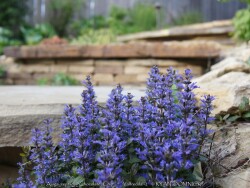

Ajugas are extremely hardy groundcovers that quickly form a dense carpet-like mat. Unlike many perennials that are grown only for their flowers, Ajuga is prized for its attractive, evergreen colorful foliage that looks nice all year. The deepest foliage color is achieved when plants are sited in full sun and in cooler temperatures although in Kansas this may result in foliage burning in summer if not adequately watered. From mid to late spring, short deep blue flower spikes stand upright above the foliage. Do not allow foliage to be covered with leaves or mulch during winter or crown rot disease may occur wiping out large patches. Ajuga reptans 'Chocolate Chip' / 'Valfredda' is the smallest and tends to spread more slowly and stay naturally compact compared to other varieties of Ajuga, making it suitable for use as an edging, rock gardens, walking trails borders and mixed container plantings. This attractive small-scale variety has tiny carpetlike purple leaves and a dense habit.


Five leaf Akebia (Akebia quinata) is a twining vine with green leaves arranged in a palmate shape. Maroon to purple flowers have the slight aroma of chocolate and bloom early in the spring. As with most vines, they are not low maintenance due to their nature and purpose in life. Vines by nature are kind of like freeloaders that want to use other things (and other plants) for free support. This does not directly parasitize the tree but can add a lot of weight (storm damage) and shade out it's foliage. It requires training to grow on some structures but will generally twine and try to grow to the highest point possible. When properly trained on a trellis or pergola, akebia can be amazing. It will grow in just about any soil and tolerate full shade to full sun. It may be used as a groundcover if nothing to climb on or an edible plant if you pollinate the flowers by hand. There are varieties available that when crossed, produce edible fruit. Akebia is invasive in some parts of the country but this is not the case in Kansas. Blooms occur in march or april very early when frosts are still occurring but with little damage to the plant. Foliage is persistent and semi evergreen until 10-15 degrees F.
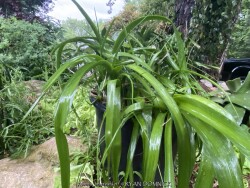

Pregnant Onion (Albuca bracteata) is typically grown in warmer zones. Considered a tropical or succulent in Kansas and used as summer patio plants with white flowers and bright green foliage. Be prepared to give away offset bulblets to all your friends! Water sparingly and place in full sun to mostly shade. Pregnant Onion can tolerate frost but protect from temperatures below 25 degrees F and move into a cold garage or basement over the winter with minimal watering. Do not allow the pot with rootball to freeze solid or go below 23 degrees for more than a few hours. Allow to go dormant with little care, just cut off dead foliage and place back out in April or May with a time-release fertilizer. Repotting may or may not be needed depending on how large you want the plant to grow; plants can continue to grow taller and tolerate extremely root-bound pots but may need wind bracing. If repotting, make sure to use a sharp draining medium organic cactus mix with plenty of sand and perlite.
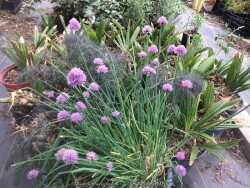

Chives (Allium schoenoprasum) are an easy to grow edible and ornamental perennial. Attractive, globular, clover-like clusters of pale purple flowers appear in spring and early summer. Grow in just about any soil including heavy clay in full to part sun. In Eastern Kansas, typically our 40 inches of rainfall is sufficient without extra water. And as with all alliums, these are completely rabbit proof. Considered a "Once it's there, it's there forever" plant!
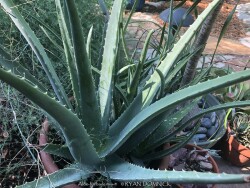

Giant Aloe is typically grown in warmer zones. Considered a tropical or succulent in Kansas and used as summer patio plants with white flowers and bright green foliage. Be prepared to give away offsets to all your friends! Water sparingly and place in mostly shade followed by full sun after acclimated. Giant Aloe can tolerate frost but protect from temperatures below 25 degrees F and move into a cold garage or basement over the winter with minimal watering. Do not allow the pot with rootball to freeze solid or go below 25 degrees for more than a few hours. It is important to avoid the combination of wet and cold. As a winter house plant, it will look presentable all winter long with just no waterings. As a permanent house plant, provide bright light and allow the soil to dry between waterings for many years of carefree enjoyment. Plants grown permanently indoors may begin to elongate stretching for light producing weak new growth. It can be hard to reproduce the intense UV sunlight they need so moving outside for the summer is best.Generally if moving outside for the summer, allow 3-4 weeks of part shade or morning sun before placing in full sun. Giant aloe is one of the slowest plants to re-acclimate to bright sunlight so this might take a month or so of protecting from full sun. Potted plants are very low maintenance. Division and re-potting will need to eventually occur as plants will get top heavy and offsets will fall out. I have never seen any insect problems on this plant. Survives each year a a long lasting annual in out display garden until about 18-20 degrees...usually into December before it looks damaged and unsightly.
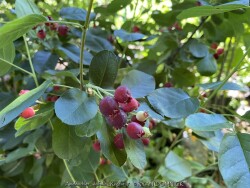

This serviceberry (Amelanchier alnifolia 'Regent') is a shrub to dwarf tree form with edible bluish-purple berry-like fruit, native to North America from Alaska across most of western Canada and in the western and north-central United States. Although it is adaptable to a variety of soil and moisture conditions, it shows some drought intolerance so go with sand plums on a drier site. The delicious fruit of this and related species are eaten fresh or prepared in puddings and pies. You need to act quick before the birds strip them clean. 'Regent' is a compact, deciduous, stoloniferous, early-flowering cultivar which typically grows only 4-6' tall. Great plant for the edible landscape!
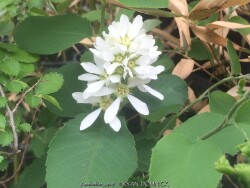

This serviceberry (Amelanchier canadensis) is a deciduous, early-flowering, large shrub or small tree which typically grows 15-25' tall with edible red to bluish-purple berry-like fruit. Native to Eastern North America. Although it is adaptable to a variety of soil and moisture conditions, it shows some drought intolerance so go with sand plums or American plums on a drier site. The delicious fruit of this and related species are eaten fresh or prepared in puddings and pies. You need to act quick before the birds strip them clean. Amelanchier canadensis is also called Shadblow Serviceberry. Great plant for the edible landscape!
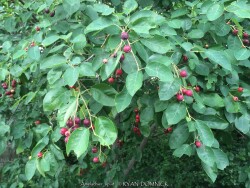

Serviceberry (Amelanchier sp.) can be a shrub or dwarf tree form with edible red to bluish-purple berry-like fruit, native to North America from Alaska across most of western Canada and in the western and north-central United States. Although it is adaptable to a variety of soil and moisture conditions, it shows some drought intolerance so go with sand plums on a drier site. The delicious fruit of this and related species are eaten fresh or prepared in puddings and pies. You need to act quick before the birds strip them clean. Great plant for the edible landscape!


This serviceberry (Amelanchier x grandiflora 'Autumn Brilliance') is a deciduous, early-flowering, large shrub or small tree which typically grows 15-25' tall with edible red to bluish-purple berry-like fruit. Native to Eastern North America. Although it is adaptable to a variety of soil and moisture conditions, it shows some drought intolerance so go with sand plums or American plums on a drier site. The delicious fruit of this and related species are eaten fresh or prepared in puddings and pies. You need to act quick before the birds strip them clean. Amelanchier x grandiflora is a hybrid cross between two species of North American serviceberry, namely, A. arborea (downy serviceberry) and A. laevis (Allegheny serviceberry). 'Autumn Brilliance' has brilliant orange-red fall color. Great plant for the edible landscape!
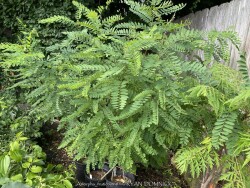

False Indigo Shrub (Amorpha fruticosa) is a 6-10 ft., loose, airy shrub which often forms dense thickets. The blooming season is relatively short but the pinnately compound leaves offers lasting interest and a "Wow" factor. The foliage is pinnately compound, fine-textured, and turns gold in the fall lasting for a week or two. Older plantings may be rejuvenated as they do develop a leggy character with the majority of their foliage on the upper third of the plant. This is a species of flowering plant in the legume family Fabaceae so it is able to make its own nitrogen. False Indigo Shrub tolerates many types of soil including wet sandy soils. Other names include desert false indigo, false indigo-bush, and bastard indigobush. It is native to North America and has potential to be invasive in parts of the country but not so much in Kansas.
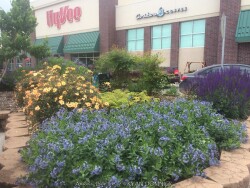

Blue Ice Amsonia (Amsonia 'Blue Ice') is a chance seedling from A. tabernaemontana which is native to North America. It bears gorgeous deep blue buds in late spring opening to vivid a periwinkle blue for about 4-6 weeks. The bright green foliage is compact and mostly pest-free. However in some years with high humidity and extra summer rainfall, the foliage gets diseased and should be cut back early. If in good air circulation, the foliage often turns a rich shade of yellow in fall characteristic of most amsonias. In Kansas Landscapes, it is usually planted as a mass groundcover growing into a dense weed proof mass. Established plants are low maintenance and almost never need to be replaced, divided or watered.


The species bluestar (Amsonia) grows up to 3 feet tall and prefers a medium to moist soil, but will tolerate a range of soils in light shade, including clay. "Once it's there, it's there forever" plant! Native to East-central U.S. in open woodlands and sunny plains. 'Storm Cloud' is and improved selection with new stems emerge near-black with leaves that are very dark green with silver veins. The stems stay dark throughout spring contrasting the light periwinkle blue, star-shaped flowers that completely cover the foliage by late spring. Some reblooming may occur for many weeks afterward. Although the main interest of this plant is in spring, it maintains a great garden presence throughout the summer and fall. Its wide, mounded habit lends itself well to be used in place of shrubs in the landscape. In some years with high humidity and extra summer rainfall, the foliage gets diseased and should be cut back early. Provide planting location with good air circulation to avoid this small problem. Compared to 'Storm Cloud', Amsonia 'Starstruck', a more compact version at 18", has wider leaves, and blooms about 1-2 weeks later in the spring. All Proven Winners® plants are legally propagated, healthy and vigorous, true to name, and tagged with color pictures and growing information.
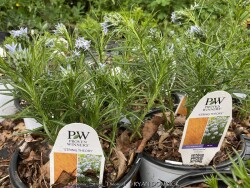

Narrow-leaf Amsonia (Amsonia hubrichtii) is clump-forming plant that is primarily grown in cultivation for its feathery green summer foliage and golden fall color. Spring flowers are powdery blue rising on 3' stalks creating a compact dense willow-like bush. The blooming season is relatively short but the pinnately compound leaves offers lasting interest and a "Wow" factor. Rich golden fall color is long-lasting and dries remaining attractive deep into the winter. No deadheading is needed and the only maintenance is cutting the plant back each winter after the fall foliage is no longer attractive. In some years with high humidity and extra summer rainfall, the foliage gets diseased and should be cut back early. Provide planting location in full sun with good air circulation to avoid this small problem. The growth is so dense that no weeds have a chance of invading a mature stand of plants. Amsonia hubrichtii is relatively new to cultivation being discovered in Arkansas in 1942 but is hardy in zones 5-9. Combine with other summer or fall flowering plants like hardy hibiscus, crapemyrtle, or penstemon. Fine-textured foliage also combines well with dark foliage, larger leaves, and dark colored walls! Great for large-scale mass plantings needing something permanent. This is a true four-seasons long-lived perennial that belongs in almost every perennial garden. String Theory Narrow-leaf Amsonia (Amsonia 'String Theory') can be described as a compact version of the industry standard Amsonia hubrichtii. All Proven Winners® plants are legally propagated, healthy and vigorous, true to name, and tagged with color pictures and growing information.
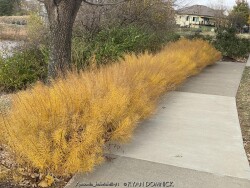

Narrow-leaf Amsonia (Amsonia hubrichtii) is clump-forming plant that is primarily grown in cultivation for its feathery green summer foliage and golden fall color. Spring flowers are powdery blue rising on 3' stalks creating a compact dense willow-like bush. The blooming season is relatively short but the pinnately compound leaves offers lasting interest and a "Wow" factor. Rich golden fall color is long-lasting and dries remaining attractive deep into the winter. No deadheading is needed and the only maintenance is cutting the plant back each winter after the fall foliage is no longer attractive. In some years with high humidity and extra summer rainfall, the foliage gets diseased and should be cut back early. Provide planting location in full sun with good air circulation to avoid this small problem. The growth is so dense that no weeds have a chance of invading a mature stand of plants. Amsonia hubrichtii is relatively new to cultivation being discovered in Arkansas in 1942 but is hardy in zones 5-9. Combine with other summer or fall flowering plants like hardy hibiscus, crapemyrtle, or penstemon. Fine-textured foliage also combines well with dark foliage, larger leaves, and dark colored walls! Great for large-scale mass plantings needing something permanent. This is a true four-seasons long-lived perennial that belongs in almost every perennial garden.
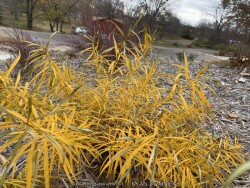

Narrow-leaf Amsonia (Amsonia hubrichtii) is clump-forming plant that is primarily grown in cultivation for its feathery green summer foliage and golden fall color. Spring flowers are powdery blue rising on 3' stalks creating a compact dense willow-like bush. The blooming season is relatively short but the pinnately compound leaves offers lasting interest and a "Wow" factor. Rich golden fall color is long-lasting and dries remaining attractive deep into the winter. No deadheading is needed and the only maintenance is cutting the plant back each winter after the fall foliage is no longer attractive. In some years with high humidity and extra summer rainfall, the foliage gets diseased and should be cut back early. Provide planting location in full sun with good air circulation to avoid this small problem. The growth is so dense that no weeds have a chance of invading a mature stand of plants. Amsonia hubrichtii is relatively new to cultivation being discovered in Arkansas in 1942 but is hardy in zones 5-9. Combine with other summer or fall flowering plants like hardy hibiscus, crapemyrtle, or penstemon. Fine-textured foliage also combines well with dark foliage, larger leaves, and dark colored walls! Great for large-scale mass plantings needing something permanent. This is a true four-seasons long-lived perennial that belongs in almost every perennial garden. Butterscotch Amsonia (Amsonia hubrichtii 'Butterscotch') is like other Amsonia in general appearance, but with improved form, reddish stems, superior rich "butterscotch" fall color, and great resistance to tip dieback. Flower color is also slightly darker blue.


Shining bluestar (Amsonia illustris) grows up to 3 feet tall and prefers a medium to moist soil, but will tolerate a range of soils in light shade, including clay. "Once it's there, it's there forever" plant! Native to Central U.S. most frequently occuring in sandy or rocky soils on gravel bars or along streams. Because it tolerates periods of brief flooding, it is an ideal amsonia for the rain-garden. This is a great amsonia for foliage quality, bearing Narrow, willow-shaped, leathery, shiny green leaves.
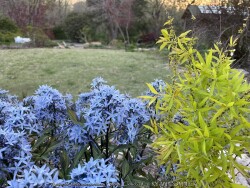

The species bluestar (Amsonia tabernaemontana) growing up to 3 feet tall and prefers a medium to moist soil, but will tolerate a range of soils in light shade, including clay. "Once it's there, it's there forever" plant! Native to East-central U.S. in open woodlands and sunny plains. Amsonia tabernaemontana 'Storm Cloud' is and improved selection with new stems emerge near-black with leaves that are very dark green with silver veins. The stems stay dark throughout spring contrasting the light periwinkle blue, star-shaped flowers that completely cover the foliage by late spring. Some reblooming may occur for many weeks afterward. Although the main interest of this plant is in spring, it maintains a great garden presence throughout the summer and fall. Its wide, mounded habit lends itself well to be used in place of shrubs in the landscape. In some years with high humidity and extra summer rainfall, the foliage gets diseased and should be cut back early. Provide planting location with good air circulation to avoid this small problem.
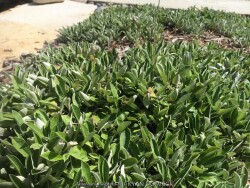

Pussytoes (Antennaria neglecta) are also known for their soft, silvery basal leaves, which spread to form a low groundcover in dry areas. Weeds have a hard time colonizing this groundcover in dry poor soil areas. Absolutely avoid planting pussytoes in moist soils or areas that have poor drainage or death will quickly occur. Native habitat across much of the Midwest and Northeast includes medium to dry black soil prairies, clay prairies, open woodlands and dry meadows. In Kansas landscapes, use as a retaining wall rock garden plant, a stepable groundcover along path, or in-between stepping stones in gravely well drained soils. Pussytoes is named for its white tufted flowers that look like tiny cat's feet. Flowers are interesting but generally best to cut before seed set as they detract from the tidy mat-like foliage. Antennaria neglecta has tiny foliage.
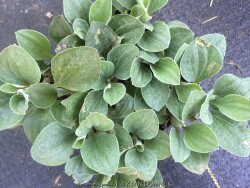

Pussytoes (Antennaria parlinii) are also known for their soft, silvery basal leaves, which spread to form a low groundcover in dry areas. Weeds have a hard time colonizing this groundcover in dry poor soil areas. Absolutely avoid planting pussytoes in moist soils or areas that have poor drainage or death will quickly occur. Native habitat across much of the Midwest and Northeast includes medium to dry black soil prairies, clay prairies, open woodlands and dry meadows. In Kansas landscapes, use as a retaining wall rock garden plant, a stepable groundcover along path, or in-between stepping stones in gravely well drained soils. Pussytoes is named for its white tufted flowers that look like tiny cat's feet. Flowers are interesting but generally best to cut before seed set as they detract from the tidy mat-like foliage. Antennaria parlinii has larger foliage and is more shade tolerant; a great plant for dry-shade.
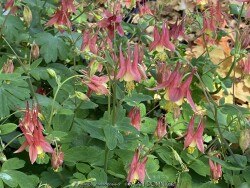

Aquilegia canadensis is a columbine native to Kansas with more tolerance for drought, heat and humidity. It still prefers cool nights preferring rich, moist soils with light to moderate shade. By keep soils uniformly moist after during and after bloom, the attractive foliage will last into June or July in Kansas. When foliage depreciates from drought or leaf miners, the plants may be cut to the ground with some regrowth and flowering possible in the fall. Flowers are reddish pink with yellow shades inside. Great for hummingbirds!
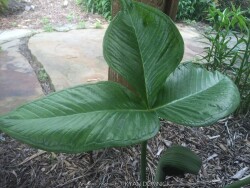

Japanese Cobra Lily (Arisaema ringens) is planted for its bright green foliage and bazaar "Cobra" hood-like flowers. Native to rich Japanese forests in humusy, medium to wet, well-drained soil in part shade to full shade, it needs a good location in the garden and will be a focal point. If foliage depreciates from drought, the plants may be cut to the ground with some regrowth and flowering possible in the fall. Combine with shade garden plants that will fill the space in summer such as hostas. Although this aroid offsetts, it is rare and uncommonly available for sale.


Red chokeberry (Aronia arbutifolia 'Brilliantissima'), is an open, upright, spreading, somewhat rounded but leggy, suckering, deciduous shrub that typically grows 6-10' tall. It is native to native to both wet and dry thickets in Eastern North America. This 3-season shrub had appeal from spring to late fall starting with white flowers, then deep green summer foliage followed by brilliant red fall color and red berries. Plant in groups or mass plantings in small gardens or open woodland areas. Ability to withstand wet conditions makes it suitable for growing on the margins of ponds, streams, or rain gardens. Watch out for deer can devour young plants (protect with chicken wire if needed) but established plantings can generally outgrow deer browsing which offer free pruning to prevent legginess. The common name of chokeberry is in reference to the tart and bitter taste of the fruits which are edible but so astringent as to cause choking in most of those who try: no it's not poison!. Fruits are renowned for its antioxidant rich berries and high nutritional value and sometimes used to make tasty jams and jellies if enough sugar is added. Included in our "edibles" database but depends on how hungry you are! Aronia arbutifolia 'Brilliantissima' grows slowly to 6-8' tall and is perhaps most noted for its attractive glossy red berries and red fall foliage color. It primarily differs from the species by being more compact. It producing more lustrous foliage with superior red fall color. It also produces larger, glossier and more abundant fruit favored by wildlife.
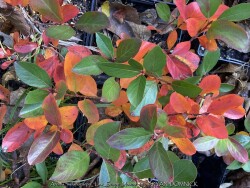

Low Scape Mound Aronia (Aronia melanocarpa 'Low Scape Mound') is a tidy little mound shaped deciduous shrub that typically grows 1-2' tall. It is native to low woods, swamps, bogs and moist thickets native from the Midwest to Canada. This 3-season shrub had appeal from spring to late fall starting with white flowers, then deep green summer foliage followed by brilliant red fall color and a few blackberries. Plant in small groups or mass plantings in small gardens. Ability to withstand wet conditions makes it suitable for growing on the margins of ponds, streams, or rain gardens. Despite 'Low Scape Mound' being touted as "drought tolerant", in the southern part of their range (Kansas), this chokeberry will decline in dry clay or alkaline soils. Watch out for deer and rabbits can devour young plants (protect with chicken wire if needed) but established plantings can generally outgrow browsing. The common name of chokeberry is in reference to the tart and bitter taste of the fruits which are edible but so astringent as to cause choking in most of those who try: no it's not poison!. Fruits are renowned for its antioxidant rich berries and high nutritional value and sometimes used to make tasty jams and jellies if enough sugar is added. Included in our "edibles" database but depends on how hungry you are! However, 'Low Scape Mound' is not grown for fruit production but rather as a compact landscape 3-season shrub tolerant of wet soils. All Proven Winners® plants are legally propagated, healthy and vigorous, true to name, and tagged with color pictures and growing information.
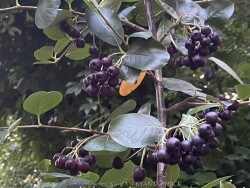

Black Chokeberry (Aronia melanocarpa), is an open, upright, spreading, somewhat rounded but leggy, suckering, deciduous shrub that typically grows 3-6' tall. It is native to low woods, swamps, bogs and moist thickets native from the Midwest to Canada. This 3-season shrub had appeal from spring to late fall starting with white flowers, then deep green summer foliage followed by brilliant red fall color and black berries. Plant in groups or mass plantings in small gardens or open woodland areas. Ability to withstand wet conditions makes it suitable for growing on the margins of ponds, streams, or rain gardens. Watch out for deer can devour young plants (protect with chicken wire if needed) but established plantings can generally outgrow deer browsing which offer free pruning to prevent legginess. The common name of chokeberry is in reference to the tart and bitter taste of the fruits which are edible but so astringent as to cause choking in most of those who try: no it's not poison!. Fruits are renowned for its antioxidant rich berries and high nutritional value and sometimes used to make tasty jams and jellies if enough sugar is added. Included in our "edibles" database but depends on how hungry you are! 'Viking' was developed in Europe for production of extra large dark purple-black fruit also used as a component of health drink juices. Aronia melanocarpa 'Viking' black chokeberry produces abundant fruit and improved fall color. Cross pollination on both varieties increases fruit production although both are self-fertile.
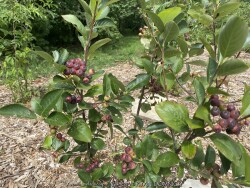

Black Chokeberry (Aronia melanocarpa), is an open, upright, spreading, somewhat rounded but leggy, suckering, deciduous shrub that typically grows 3-6' tall. It is native to low woods, swamps, bogs and moist thickets native from the Midwest to Canada. This 3-season shrub had appeal from spring to late fall starting with white flowers, then deep green summer foliage followed by brilliant red fall color and black berries. Plant in groups or mass plantings in small gardens or open woodland areas. Ability to withstand wet conditions makes it suitable for growing on the margins of ponds, streams, or rain gardens. Watch out for deer can devour young plants (protect with chicken wire if needed) but established plantings can generally outgrow deer browsing which offer free pruning to prevent legginess. The common name of chokeberry is in reference to the tart and bitter taste of the fruits which are edible but so astringent as to cause choking in most of those who try: no it's not poison!. Fruits are renowned for its antioxidant rich berries and high nutritional value and sometimes used to make tasty jams and jellies if enough sugar is added. Included in our "edibles" database but depends on how hungry you are! 'Viking' was developed in Europe for production of extra large dark purple-black fruit also used as a component of health drink juices.
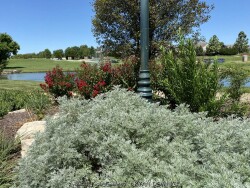

Powis Castle Artemisia (Artemisia 'Powis Castle') beautiful drought tolerant woody perennial valued for its finely dissected, aromatic, silver-gray foliage. It is evergreen down to 0 degrees F, if colder than -5degrees F, woody growth dies back too. Flowering is non-existant. As a perfect companion to vibrant flowering plants and ornamental grasses, it adds unique contrasting color and texture to waterwise landscapes. Most artemisias are best grown in poor to moderately fertile, dry to medium moisture, well-drained soils in full sun. In order to avoid occasional winter-kill in Kansas landscapes, it is advisable to plant on a south, east or west side of house or on south facing slopes or berms. Excellent soil drainage is essential for growing this plant well as poor lanky growth and root rot will occur in moist to wet soils. Tolerant of part-shade if kept dry. Cut back to 3-6" in early spring after dried winter silvery foliage stops looking attractive. New growth will emerge from the crown in mid-spring. If low temperatures hit -10 degrees F, it may kill an un-mulched plant; protect any zone 6 perennial with thick layer of mulch. General foliage decline may occur in hot and humid summer climates of the Southeast US but this is rarely a problem in Kansas or Oklahoma.
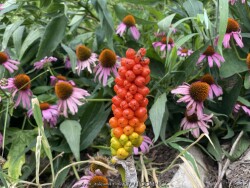

Italian Painted Arum (Arum italicum 'Pictum') is native to the Mediterranean region. It has a reversed or off-schedule life cycle; growing when other plants have already shed their leaves to take advantage of sunlight and lack of competition. It is often planted for its unusual evergreen leaf pattern and color resembling a bright green house plant growing outside in winter. Foliage goes dormant by June but is followed by naked stalks emerging from the ground with reddish orange berries. Foliage re-appears in fall and lasts well into winter untouched. If low temperatures hit 0 degrees F, foliage finally dies back to the ground and re-emerges in early spring to repeat the life cycle. If low temperatures hit -15 degrees F, it may kill an un-mulched plant; protect any zone 5/6 perennial with a 2-3" thick layer of mulch. Grow in average to rich well drained garden soil in full sun or full shade with everything in between. Moderate dry shade does not seem to be a problem because arum goes dormant anyways in the heat of summer. This holds true for planting in sunny locations to. Combine with shade garden plants that will fill the space in summer such as hostas or solomon seal. Also great when combined with late-emerging spring perennials (like plumbago, hardy hibiscus, and orange butterfly weed) because it fills that early spring space starting to grow extremely early with freeze-resistant foliage. Then later in the summer when Arum goes dormant, these plants hide the dying foliage and void left in the garden; what a great way for two species to share the same garden space! It has potential to be invasive in parts of the country such as the Pacific Northeast USA but not in Kansas. It is very stable but does not self-seed or spread in Lawrence, KS gardens; bulb offsets develop but only thicken the existing clump over time. Considered to be a great permatanet multi-season perennial for your garden.


Arundinaria gigantea is also called Canebrake (a tall thicket of any of a variety of Arundinaria) This species, along with its shorter form, 'Tecta', are the only bamboos native to the United States. It once covered huge swaths of rich bottomland along stream valleys and ravines throughout the southeastern United States but have been widely replaced by agriculture. Although still seen in small patches, it can reproduce asexually and rapidly. This adaptation that allows them to persist quietly in the shade of a forest for years and rapidly take advantage of disturbance which disrupts the overstory, such as blowdowns, floods or hurricanes. As a landscape plant, use the same as you would use oriental bamboo in large areas for a evergreen noise, wind, visual screening. Foliage is evergreen to 0 to 5 degrees F. Canes will defoliate at -5 to -10 degrees F. Canes die to the ground at -10 to -15 degrees. Root system will survive up to -25 to -30 degrees F as a perennial especially if mulched. Arundinaria gigantea usually grows 10-15' feet tall in Kansas. Every few years a grove will experience complete winterkill: it is strongly advised to cut all dead growth to the ground for aesthetic reasons and and fire prevention. The 'Tecta' form looks similar but only grows 6-8 feet tall and is tolerant of wet soil.
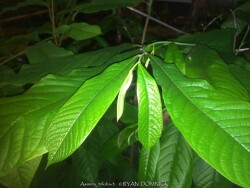

Paw Paw (Asimina triloba) is a tropical looking native understory fruit tree with large green leaves and delicious fruits. Flowers are born on old wood in the early spring and the maroon color is common of flowers meant to attract flies for pollination. Foliage is up to 12 inches long and turns a brilliant yellow in autumn for a couple weeks before falling. If cross pollination occurs, delicious fruits are produced in small clusters. The texture is custard like and taste is a mix between banana, mango, and hint of pineapple. Fruit is very fragile upon ripening and will fall to the ground and splat or be quickly devoured by animals. It is suggested that you put fruit nets around the clusters of fruit or harvest a few days earlier and allow to ripen inside. Fruit is rarely commercially available due to its fragility and short shelf-life. Cleaned fruit may be peeled frozen with seed intact: they can be picked out much easier when thawed out again Paw Paw may be eaten fresh, baked into desserts, or made into ice cream. Paw Paw is native to a large geographical area over eastern United States including Kansas. In the wild, Paw Paw grows in moist rich forest valleys in full to part shade. Best fruiting specimens can also be found on the edge of woodland or clearing in rich soil. Paw Paw tree colonies slowly spread by rhizomes and seem to occupy the forest understory sometimes for decades or centuries waiting for an opening to allow sunlight in. If a large canopy tree (such as an oak) dies or wind storm rolls through clearing a patch, new sunlight and an opening in the canopy occurs paving the way for sexual reproduction to take place (fruits) Paw Paw is somewhat tolerant of poorly drained soil's including clay but growth will be much slower. Interestingly, Paw Paws will tolerate and even need full sun when older to produce fruit. However, young saplings will quickly die in full sun from leaf burn and drought stress. If a tree is at least 4 to 6 tall and is planted in rich soil and full sun with regular irrigation, it will probably be fine. With these growing conditions, trees may grow at a median growth rate instead of slow, putting up 1 to 2 feet of new growth per year. If you have the right conditions for a Paw Paw tree, it should definitely be a part of your landscape whether you are growing for fruit production or not. There are dozens on improved cultivars available now days. In our Lawrence, KS display gardens, we are trialing several of these improved fruiting cultivars from Forrest Keeling Nursery in Missouri.


Paw Paw (Asimina triloba) is a tropical looking native understory fruit tree with large green leaves and delicious fruits. Flowers are born on old wood in the early spring and the maroon color is common of flowers meant to attract flies for pollination. Foliage is up to 12 inches long and turns a brilliant yellow in autumn for a couple weeks before falling. If cross pollination occurs, delicious fruits are produced in small clusters. The texture is custard like and taste is a mix between banana, mango, and hint of pineapple. Fruit is very fragile upon ripening and will fall to the ground and splat or be quickly devoured by animals. It is suggested that you put fruit nets around the clusters of fruit or harvest a few days earlier and allow to ripen inside. Fruit is rarely commercially available due to its fragility and short shelf-life. Cleaned fruit may be peeled frozen with seed intact: they can be picked out much easier when thawed out again Paw Paw may be eaten fresh, baked into desserts, or made into ice cream. Paw Paw is native to a large geographical area over eastern United States including Kansas. In the wild, Paw Paw grows in moist rich forest valleys in full to part shade. Best fruiting specimens can also be found on the edge of woodland or clearing in rich soil. Paw Paw tree colonies slowly spread by rhizomes and seem to occupy the forest understory sometimes for decades or centuries waiting for an opening to allow sunlight in. If a large canopy tree (such as an oak) dies or wind storm rolls through clearing a patch, new sunlight and an opening in the canopy occurs paving the way for sexual reproduction to take place (fruits) Paw Paw is somewhat tolerant of poorly drained soil's including clay but growth will be much slower. Interestingly, Paw Paws will tolerate and even need full sun when older to produce fruit. However, young saplings will quickly die in full sun from leaf burn and drought stress. If a tree is at least 4 to 6 tall and is planted in rich soil and full sun with regular irrigation, it will probably be fine. With these growing conditions, trees may grow at a median growth rate instead of slow, putting up 1 to 2 feet of new growth per year. If you have the right conditions for a Paw Paw tree, it should definitely be a part of your landscape whether you are growing for fruit production or not. There are dozens on improved cultivars available now days. In our Lawrence, KS display gardens, we are trialing several of these improved fruiting cultivars from Forrest Keeling Nursery in Missouri. Asimina triloba 'Mango' features exceptionally large fruit with flavorful yellow flesh. This has the most vigorous growth of pawpaw varieties. Fruit is late ripening.
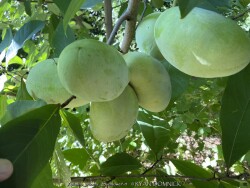

Paw Paw (Asimina triloba) is a tropical looking native understory fruit tree with large green leaves and delicious fruits. Flowers are born on old wood in the early spring and the maroon color is common of flowers meant to attract flies for pollination. Foliage is up to 12 inches long and turns a brilliant yellow in autumn for a couple weeks before falling. If cross pollination occurs, delicious fruits are produced in small clusters. The texture is custard like and taste is a mix between banana, mango, and hint of pineapple. Fruit is very fragile upon ripening and will fall to the ground and splat or be quickly devoured by animals. It is suggested that you put fruit nets around the clusters of fruit or harvest a few days earlier and allow to ripen inside. Fruit is rarely commercially available due to its fragility and short shelf-life. Cleaned fruit may be peeled frozen with seed intact: they can be picked out much easier when thawed out again Paw Paw may be eaten fresh, baked into desserts, or made into ice cream. Paw Paw is native to a large geographical area over eastern United States including Kansas. In the wild, Paw Paw grows in moist rich forest valleys in full to part shade. Best fruiting specimens can also be found on the edge of woodland or clearing in rich soil. Paw Paw tree colonies slowly spread by rhizomes and seem to occupy the forest understory sometimes for decades or centuries waiting for an opening to allow sunlight in. If a large canopy tree (such as an oak) dies or wind storm rolls through clearing a patch, new sunlight and an opening in the canopy occurs paving the way for sexual reproduction to take place (fruits) Paw Paw is somewhat tolerant of poorly drained soil's including clay but growth will be much slower. Interestingly, Paw Paws will tolerate and even need full sun when older to produce fruit. However, young saplings will quickly die in full sun from leaf burn and drought stress. If a tree is at least 4 to 6 tall and is planted in rich soil and full sun with regular irrigation, it will probably be fine. With these growing conditions, trees may grow at a median growth rate instead of slow, putting up 1 to 2 feet of new growth per year. If you have the right conditions for a Paw Paw tree, it should definitely be a part of your landscape whether you are growing for fruit production or not. There are dozens on improved cultivars available now days. In our Lawrence, KS display gardens, we are trialing several of these improved fruiting cultivars from Forrest Keeling Nursery in Missouri. Asimina triloba 'Sunflower' is a well-known, hardy selection originally from Chanute, Kansas. It ripens later than other varieties with large, flavorful fruit and is at lease partially self-fertile. Fruit has been described as tasting of mango, apricot, pineapple, banana and vanilla.